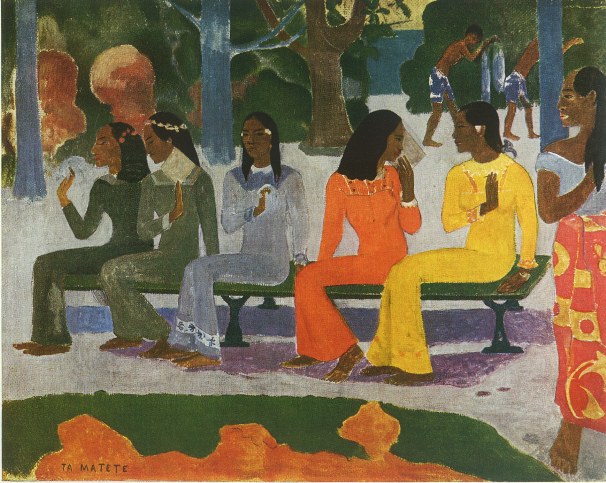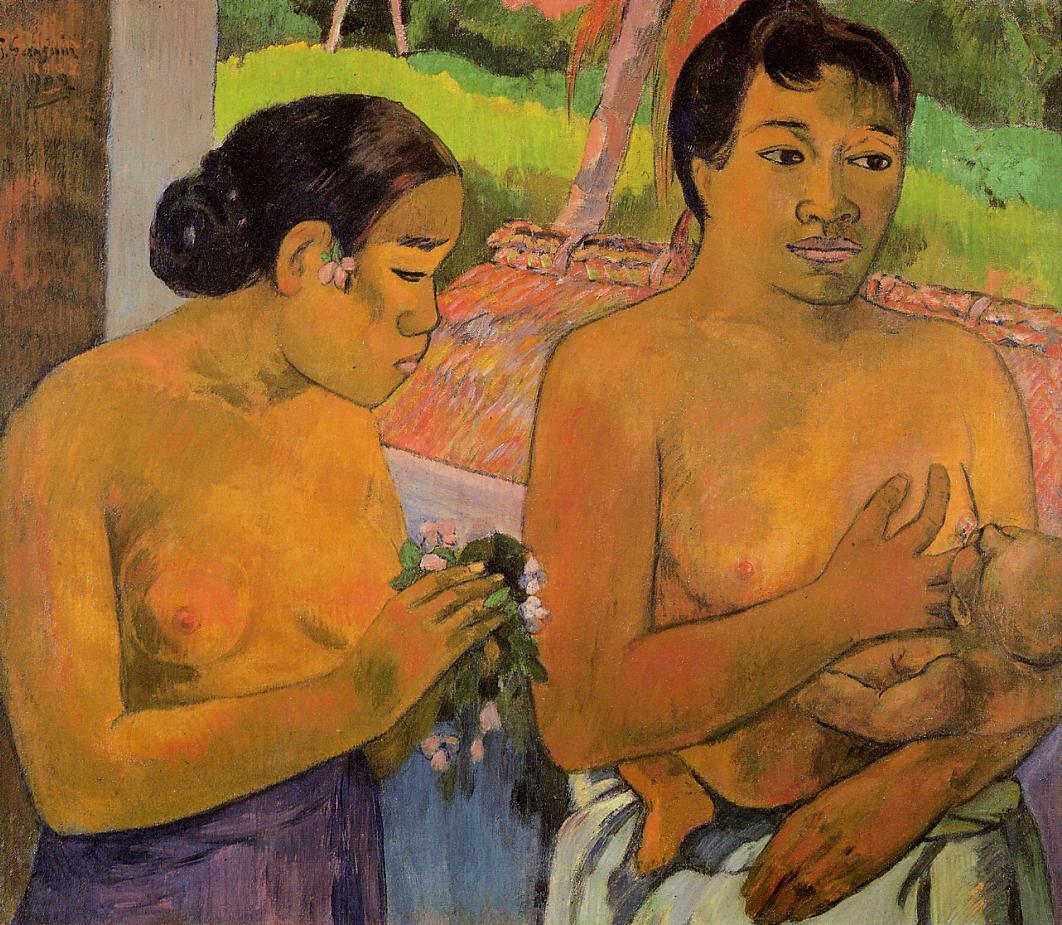The Yellow Christ (Le Christ jaune)
1889, oil on canvas. Albright-Knox Art Gallery, Buffalo, NY, USA
We Shall Not Go to the Market Today (1892)
This picture nicely illustrates Gauguin’s preoccupation with motives of ancient Egyptian art. On display in the Kunstmuseum, Basel.
Where Do We Come From? What Are We? Where Are We Going? 1897, oil on canvas
is one of Paul Gauguin’s most famous paintings. Created in Tahiti, it is currently housed at the Museum of Fine Arts in Boston, Massachusetts, USA.
Gauguin left for Tahiti in 1891, looking for a society more elemental and simplistic than that of his native France. In addition to several other paintings that he created which express a highly individualistic mythology, he began this painting in 1897 and finished it by 1898, considering it a masterpiece and grand culmination of his thoughts.
The curators of Boston’s Museum of Fine Arts, where the painting now resides, are continuously updating their record of the painting’s ownership history, suggesting that their list is not comprehensive. In any case, in 1898, Gauguin sent the painting to Georges Daniel de Monfreid in Paris. Subsequently, it was consigned and sold to several other Parisian and European merchants and collectors until it was purchased by the Marie Harriman Gallery in New York in 1936. The Museum of Fine Arts in Boston acquired it from the Marie Harriman Gallery on 16 April 1936.
It is on display at the Boston Museum of Fine Arts (MFA). It is approximately five feet (1.5 m) high and over twelve feet (3.60 m) long.
Gauguin—after vowing that he would commit suicide following this painting’s completion, something he had previously attempted—indicated that the painting should be read from right to left, with the three major figure groups illustrating the questions posed in the title. The three women with a child represent the beginning of life; the middle group symbolizes the daily existence of young adulthood; and in the final group, according to the artist, “an old woman approaching death appears reconciled and resigned to her thoughts;” at her feet, “a strange white bird…represents the futility of words.” The blue idol in the background apparently represents what Gauguin described as “the Beyond.” Of its entirety he said, “I believe that this canvas not only surpasses all my preceding ones, but that I shall never do anything better—or even like it.”
The painting is an accentuation of Gauguin’s trailblazing postimpressionistic style; his art stressed the vivid use of colors and thick brushstrokes, tenets of the impressionists, while it aimed to convey an emotional or expressionistic strength. It emerged in conjunction with other avant-garde movements of the twentieth century, including cubism and fauvism.
 Paul Gauguin
Paul Gauguin
Born: June 7, 1848, Paris, France
Died: May 8, 1903, Atuona
Eugène Henri Paul Gauguin was a leading Post-Impressionist artist. Best known as a painter, his bold experimentation with coloring led directly to the Synthetist style of modern art while his expression of the inherent meaning of the subjects in his paintings, under the influence of the cloisonnist style, paved the way to Primitivism and the return to the pastoral. He was also an influential exponent of wood engraving and woodcuts as art forms.
Born in Paris, he was descended from Spanish settlers in South America and the viceroy of Peru, and spent his early childhood in Lima. He was, through Alina María Chazal, the grandson of Flora Tristan, a founder of modern feminism. After his education in Orléans, France, Gauguin spent six years sailing around the world in the merchant marines and then in the French navy. Upon his return to France in 1870, he took a job as a broker’s assistant. His guardian Gustave Arosa, a successful businessman and art collector, introduced Gauguin to Camille Pissarro in 1875.
A successful stockbroker during week-days, Gauguin spent holidays painting with Pissarro and Cézanne. Although his first efforts were clumsy, he made rapid progress. By 1884 Gauguin had moved with his family to Copenhagen, where he unsuccessfully pursued a business career. Driven to paint full-time, he returned to Paris in 1885, leaving his family in Denmark. Without adequate subsistence, his wife (Mette Sophie Gadd) and their five children returned to her family. Gauguin outlived two of his children.
Like his friend Vincent Van Gogh, with whom he spent nine weeks painting in Arles, Paul Gauguin experienced bouts of depression and at one time attempted suicide. Disappointed with Impressionism, he felt that traditional European painting had become too imitative and lacked symbolic depth. By contrast, the art of Africa and Asia seemed to him full of mystic symbolism and vigour. There was a vogue in Europe at the time for the art of other cultures, especially that of Japan (Japonisme). He was invited to participate in the 1889 exhibition organized by Les XX.
Under the influence of folk art and Japanese prints, Gauguin evolved towards Cloisonnism, a style given its name by the critic Édouard Dujardin in response to Emile Bernard’s cloisonne enamelling technique. Gauguin was very appreciative of Bernard’s art and of his daring with the employment of a style which suited Gauguin in his quest to express the essence of the objects in his art. In The Yellow Christ (1889), often cited as a quintessential Cloisonnist work, the image was reduced to areas of pure colour separated by heavy black outlines. In such works Gauguin paid little attention to classical perspective and boldly eliminated subtle gradations of colour—thus dispensing with the two most characteristic principles of post-Renaissance painting. His painting later evolved towards “Synthetism” in which neither form nor colour predominate but each has an equal role.
In 1891, Gauguin, frustrated by lack of recognition at home and financially destitute, sailed to the tropics to escape European civilization and “everything that is artificial and conventional.” (Before this he had made several attempts to find a tropical paradise where he could ‘live on fish and fruit’ and paint in his increasingly primitive style, including short stays in Martinique and as a worker on the Panama Canal). Living in Mataiea Village in Tahiti, he painted “Fatata te Miti” (“By the Sea”), “La Orana Maria” (Ave Maria) and other depictions of Tahitian life. He moved to Punaauia in 1897, where he created the masterpiece painting “Where Do We Come From” and then lived the rest of his life in the Marquesas Islands, returning to France only once. His works of that period are full of quasi-religious symbolism and an exoticized view of the inhabitants of Polynesia. In Polynesia he clashed often with the colonial authorities and with the Catholic Church. During this period he also wrote the book Avant et Après (before and after), that is a fragmented collection of observations about life in Polynesia, memories from his life and comments on literature and paintings. In 1903 due to a problem with the church and the government he was sentenced to three months in prison, and he owed a fine. At that time he was being supported by an art dealer. He died of syphilis before he could start the prison sentence. His body had been weakened by alcoholism and a dissipated life style. He was 54 years old.
Quotations by Gauguin
- Life is like a song, you have to enjoy it while it plays because you never know if it will come on again.
- Life is like a boardwalk. There may be some tacks and nails, but you will get through it.
- In order to do something new we must go back to the source, to humanity in its infancy.
- I have tried to make everything breathe in this painting: belief, passive suffering, religious and primitive style, and the great nature with its scream.
- How do you see this tree? Is it really green? Use green, then, the most beautiful green on your palette. And that shadow, rather blue? Don’t be afraid to paint it as blue as possible.
- To me, barbarism is a rejuvenation.
- Art is either plagiarism or revolution.
- I shut my eyes in order to see.
- Life being what it is, one dreams of revenge.
- Where do we come from? What are we? Where are we going?
- How long have I been here? Hence, foreword, for I shall not know. For I have been traveling for too long. My bones too weary to remember my age. Hence, how long have I been here? Thou shalt never know.
The vogue for Gauguin’s work started soon after his death. Many of his later paintings were acquired by the Russian collector Sergei Shchukin. A substantial part of his collection is displayed in the Pushkin Museum and the Hermitage. Gauguin paintings are rarely offered for sale; their price may be as high as $39.2 million US Dollars.
Gauguin influenced many other painters, but one especially notable connection is his imparting to Arthur Frank Mathews the use of an intense color palette. Mathews met Gauguin in the late 1890s while both were at the Academie Julian. Mathews took this influence in his founding of the California Arts and Crafts or California Decorative movement.
The Japanese styled Gauguin Museum, opposite the Botanical Gardens of Papeari in Papeari, Tahiti, contains some exhibits, documents, photographs, reproductions and original sketches and block prints of Gauguin and Tahitians. In 2003, the Paul Gauguin Cultural Center opened in Atuona in the Marquesas Islands.










